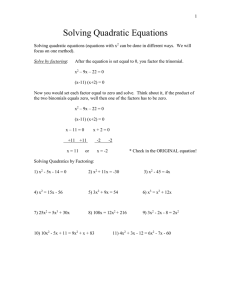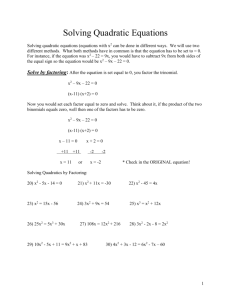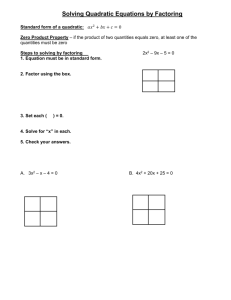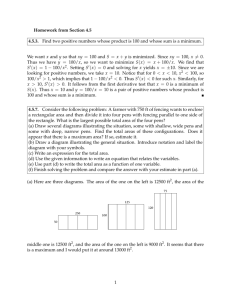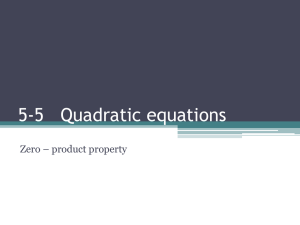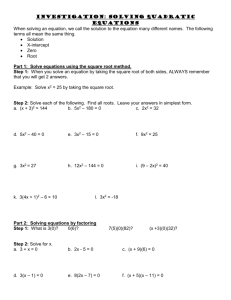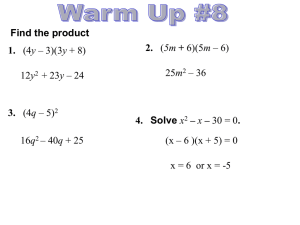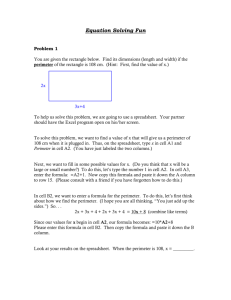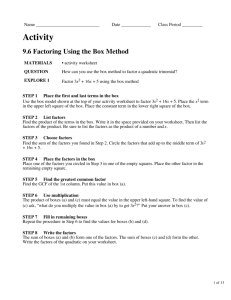Solving Quadratic Equations
advertisement
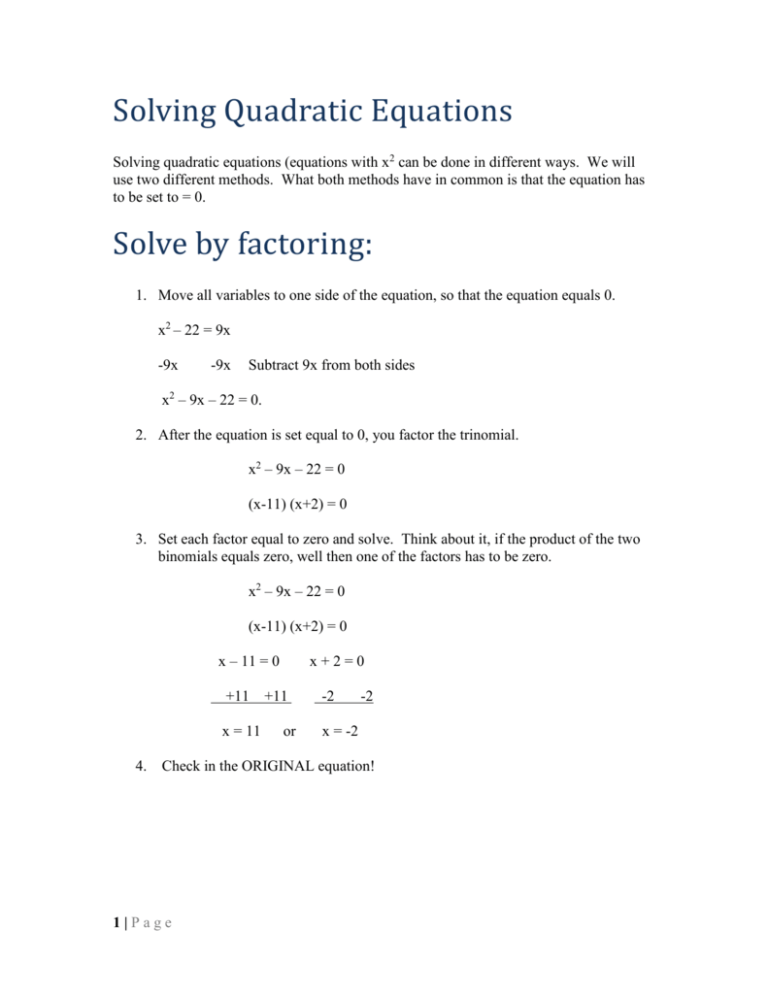
Solving Quadratic Equations Solving quadratic equations (equations with x2 can be done in different ways. We will use two different methods. What both methods have in common is that the equation has to be set to = 0. Solve by factoring: 1. Move all variables to one side of the equation, so that the equation equals 0. x2 – 22 = 9x -9x -9x Subtract 9x from both sides x2 – 9x – 22 = 0. 2. After the equation is set equal to 0, you factor the trinomial. x2 – 9x – 22 = 0 (x-11) (x+2) = 0 3. Set each factor equal to zero and solve. Think about it, if the product of the two binomials equals zero, well then one of the factors has to be zero. x2 – 9x – 22 = 0 (x-11) (x+2) = 0 x – 11 = 0 +11 x = 11 4. x+2=0 +11 or -2 -2 x = -2 Check in the ORIGINAL equation! 1|Page Solve the following equations using the factoring method: 1. x2 - 5x - 14 = 0 7. 25x2 = 5x3 + 30x 2. x2 + 11x = -30 8. 108x = 12x2 + 216 3. x2 - 45 = 4x 9. 3x2 - 2x - 8 = 2x2 4. x2 = 15x - 56 10. 10x2 - 5x + 11 = 9x2 + x + 83 5. 3x2 + 9x = 54 11. 4x2 + 3x - 12 = 6x2 - 7x - 60 6. x3 = x2 + 12x 2|Page Solve using the quadratic formula: When you can not factor an equation, you need to use the quadratic formula. Any equation can be solved with the quadratic formula, but it is a longer method, which means you should try to factor first. When ax2 + bx + c = 0 b b 4ac x 2a 2 a is the coefficient of x2 b is the coefficient of x c is the number (third term) Notice the ± factoring) is what will give your two answers (just like you had when solving by x2 – 9x – 22 = 0 a= 1 x = -b ± √b2 – 4ac . b= -9 c= -22 x= -(-9) ± √ (-9)2 – 4(1)(-22) 2(1) x= 9 ± √81 + 88 2 x= 9 ± √169 . 2 2a Split and do the + side and - side 9 – 13 2 9 + 13 2 x = 11 or * Check in the ORIGINAL equation! 3|Page x = -2 -4(1)(-22) = 88 Solving Quadratics Using the Quadratic Formula (use a separate piece of paper): 12. 2x2 - 6x + 1 = 0 15. 7x2 = 3x + 2 13. 3x2 + 2x = 3 16. 3x2 + 6 = 5x 14. 4x2 + 2 = -7x 17. 9x - 3 = 4x2 Mixed Equations: Figure out what type of equation you have and then pick a strategy to solve. 1) 20 - (5/8)x = 40 11) 9(3x + 1) = 8(5x + 6) 2) 6(7x - 2) = 8(4x + 1) 12) 15x = x2 - 16 3) 2(5x - 4) - 3(4x + 3) = -43 13) x2 + 8x = 12 4) x2 + 44 = 15x 14) 9(4x + 7) - 6(7x + 10) = -54 5) 3x2 + 18x = 81 15) 44 = 20 - 2x 6) 3x2 = 5x + 5 16) 4x2 - 128 = 16x 7) 11x - 5 = 7x - 53 17) 3x2 - 8x + 6 = x + 6 8) 6(3x + 1) + 5(10 - 4x)= 39 18) 7(6x + 2) = 10(3x + 5) 9) ¼x - 33 = -49 19) 3x2 + 13x - 12 = 9x2 - 11x - 12 10) 7x2 - 1 = 3x 20) 2x2 - 14 = 10x 21) The area of a rectangle is 108 sq. feet. The length is 3 more than the width. Find the perimeter. (must use let) 24) The area of a rectangle is 104 cm2. The length is 3 less than double the width. Find the perimeter. (must use let) 22) The area of a rectangle is 176 sq. feet. The width is 5 less than the length. Find the perimeter. (must use let) 25) The area of a rectangle is 198 ft2. The length is 4 more than double the width. Find the perimeter. (must use let) 23) The area of a rectangle is 135 sq. feet. The length is 6 more than the width. Find the perimeter. (must use let) 26) The area of a rectangle is 160 in2. The width is 2 more than half the length. Find the perimeter. (must use let) 4|Page
